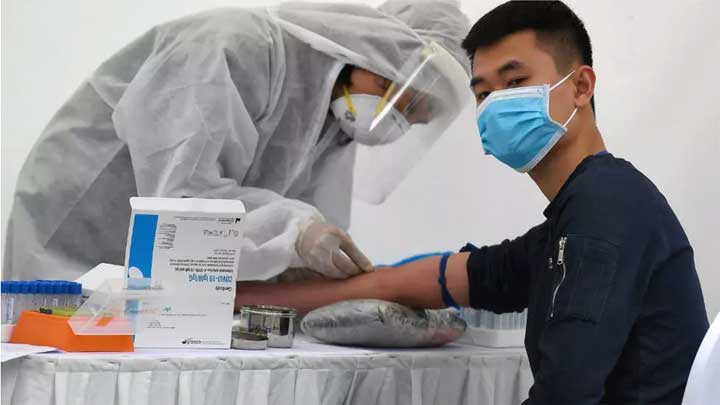News Desk
The global mortality trend revealed that COVID-19 is killing more men than women.
The inconsistency between the death rate among men and women was first noted in China, where the ratios revealed that 2.8 % of men who caught the virus had died, compared with 1.7% of women who contracted it.
The researchers have found the same trend was seen in Italy where the death rate is currently 7.2% for men and 4.1% for women.
According to reports in South Korea, where extensive testing was carried out, despite showing that the proportion of women who tested positive for the virus was higher than that of men, about 54% of the reported deaths were still among men.
This is not the first pandemic which is tilled more towards males but the past studies of the severe acute respiratory syndrome (SARS) and Middle East respiratory syndrome (MERS) outbreaks were also found to affect men more significantly.
Why are men more likely to die from coronavirus than women? While scientists have not been able to give a definitive answer yet, there are several theories.
Dr Sara Kayat who is practising NHS and private GP in the UK, tells some reasons being the case through her report first published in Aljazeera News.
Unhealthy lifestyle
One theory is that men are more likely to partake in unhealthy habits, which are associated with developing chronic diseases.
From the data collected so far, we are aware that those who have suffered more severely from COVID-19 had underlying health conditions like raised blood pressure, heart disease and lung disease. It may be down to lifestyle choices that these conditions are more common among men, and that COVID-19 is, therefore, more fatal in men.
Among these lifestyle choices are alcohol and tobacco consumption. Data gathered in 2015 by the World Health Organization (WHO) shows that men drink about five times more alcohol than women. Men are also nearly five times as likely to smoke as women.
Smokers are considered at risk of developing complications such as respiratory difficulties and pneumonia if they catch coronavirus because their respiratory health is likely to be poor. They are also at increased risk of having an underlying respiratory condition like chronic obstructive pulmonary disease (COPD), a type of lung disease, which may be exacerbated by the virus.
It may even be that smokers are more likely to catch the virus in the first place because of the action of putting your hand to mouth, using unwashed hands to roll cigarettes or even sharing cigarettes.
The studies in China did indeed confirm that more men smoked, with 50 percent of men and only 3 percent of women being smokers across the general population, so it is unsurprising that this smoking theory was one of the first to explain the gender discrepancy.
However, with more data emerging from other countries, this theory was no longer considered adequate in entirely explaining the difference. This is because in Italy, where the smoking balance is more equal (7 million men versus 4.5 million women are smokers), it could not provide the full reason why more men in Italy were dying from coronavirus.
Hand-washing
Hand-washing with soap is considered the most cost-effective intervention for the control of disease, and we have been reminded of the need to wash our hands with warm water and soap regularly and thoroughly as one way to reduce our chances of being infected with COVID-19.
However, there have been studies to suggest that men may be worse at hand hygiene than women.
A 2009 US study showed that only 31 percent of men washed their hands after using a public toilet, for example, compared with 65 percent of women. Women were also more likely to use soap when washing their hands.
However, we are aware that the number of women actually contracting the virus is almost equal to that of men, it is just that more men are dying from it. Therefore, hand-washing discrepancies are unlikely to be the cause of increased death rates in men.
Men do not seek help
Men’s health literacy and behaviour are very different from that of women.
Men are less likely to pay a visit to their GP and also less likely to acknowledge illness or seek help when they are sick.
Studies suggest that the reason for this difference is due to a perceived “femininity” of health concerns, and that risk-taking behaviour are a masculine trait.
It may therefore be that while both men and women are contracting the virus equally, women are seeking medical help earlier, while men are waiting until their symptoms have become severe, thereby reducing their chances of survival.
Immune system responses
From studies of other viruses, including other coronaviruses, we know that women provoke a greater immune response to a viral attack than men.
This means that women are generally quicker to clear a virus, and to reduce its viral load – the quantity of the virus in an infected person.
The unfortunate payoff for this more efficient immune response is that women are more likely to suffer from autoimmune conditions as a result. In addition to being more efficient at producing antibodies against the pathogen, women may also be producing more “self-reactive” antibodies – those capable of attacking the body’s own tissue, resulting in autoimmune conditions.
The slower, less efficient response of the male immune system may be one of the reasons why COVID-19 affects men more significantly overall.
Hormones
A suggested explanation for the immunological difference between men and women may be due to hormones.
Studies have shown that immunity to viruses varies with changes in hormone concentrations, which occur at different stages of the menstrual cycle, and which can be affected by taking contraception, during pregnancy and after the menopause.
Therefore, it is feasible that female hormones might be, in part, responsible for the COVID-19 gender imbalance.
This theoretical difference was researched in animal studies during the SARS outbreak in 2002 to 2003. When researchers removed the ovaries of mice, which produce the female hormone, oestrogen, or treated the female mice with a chemical that blocked the effects of oestrogen, they found that the mice’s susceptibility to SARS increased and resulted in an increased rate of death
This implies that oestrogen has a protective effect in mice infected with SARS.
As the SARS virus and COVID-19 share 79 percent of the same genetic sequencing, it is possible that a similar mechanism may be at play with COVID-19.
X chromosome
Another reason that women’s immune systems may function differently is because of the extra X chromosome that women have.
Women have two X chromosomes (XX) while men only have one (XY), and this is considered relevant to the immune response because a significant number of genes that regulate our immune response are coded on the X chromosome. This is theoretical. However, it may be that having the second X confers some advantage.
While there has been no firm explanation yet for why more men are affected by COVID-19, we are likely to understand more about this as we receive more information from immunology and antibody studies.
The differences that underpin the sexes are complex and I suspect that the answer lies in the combination of behavioural, immunological, hormonal and genetic factors.








